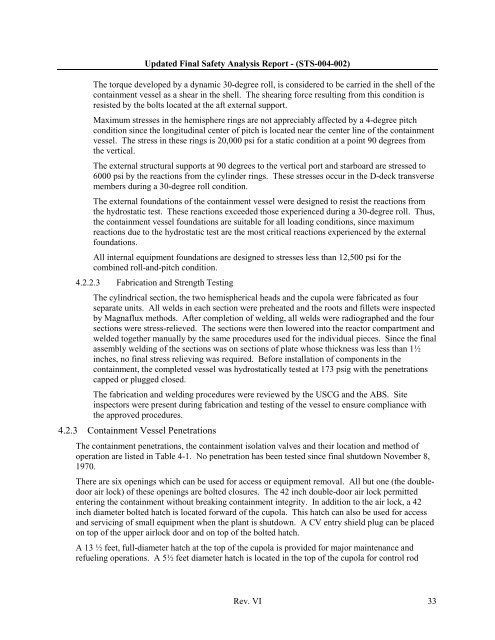10 CFR 50.71(e) - Maritime Administration - U.S. Department of ...
10 CFR 50.71(e) - Maritime Administration - U.S. Department of ...
10 CFR 50.71(e) - Maritime Administration - U.S. Department of ...
Create successful ePaper yourself
Turn your PDF publications into a flip-book with our unique Google optimized e-Paper software.
Updated Final Safety Analysis Report - (STS-004-002)The torque developed by a dynamic 30-degree roll, is considered to be carried in the shell <strong>of</strong> thecontainment vessel as a shear in the shell. The shearing force resulting from this condition isresisted by the bolts located at the aft external support.Maximum stresses in the hemisphere rings are not appreciably affected by a 4-degree pitchcondition since the longitudinal center <strong>of</strong> pitch is located near the center line <strong>of</strong> the containmentvessel. The stress in these rings is 20,000 psi for a static condition at a point 90 degrees fromthe vertical.The external structural supports at 90 degrees to the vertical port and starboard are stressed to6000 psi by the reactions from the cylinder rings. These stresses occur in the D-deck transversemembers during a 30-degree roll condition.The external foundations <strong>of</strong> the containment vessel were designed to resist the reactions fromthe hydrostatic test. These reactions exceeded those experienced during a 30-degree roll. Thus,the containment vessel foundations are suitable for all loading conditions, since maximumreactions due to the hydrostatic test are the most critical reactions experienced by the externalfoundations.All internal equipment foundations are designed to stresses less than 12,500 psi for thecombined roll-and-pitch condition.4.2.2.3 Fabrication and Strength TestingThe cylindrical section, the two hemispherical heads and the cupola were fabricated as fourseparate units. All welds in each section were preheated and the roots and fillets were inspectedby Magnaflux methods. After completion <strong>of</strong> welding, all welds were radiographed and the foursections were stress-relieved. The sections were then lowered into the reactor compartment andwelded together manually by the same procedures used for the individual pieces. Since the finalassembly welding <strong>of</strong> the sections was on sections <strong>of</strong> plate whose thickness was less than 1½inches, no final stress relieving was required. Before installation <strong>of</strong> components in thecontainment, the completed vessel was hydrostatically tested at 173 psig with the penetrationscapped or plugged closed.The fabrication and welding procedures were reviewed by the USCG and the ABS. Siteinspectors were present during fabrication and testing <strong>of</strong> the vessel to ensure compliance withthe approved procedures.4.2.3 Containment Vessel PenetrationsThe containment penetrations, the containment isolation valves and their location and method <strong>of</strong>operation are listed in Table 4-1. No penetration has been tested since final shutdown November 8,1970.There are six openings which can be used for access or equipment removal. All but one (the doubledoorair lock) <strong>of</strong> these openings are bolted closures. The 42 inch double-door air lock permittedentering the containment without breaking containment integrity. In addition to the air lock, a 42inch diameter bolted hatch is located forward <strong>of</strong> the cupola. This hatch can also be used for accessand servicing <strong>of</strong> small equipment when the plant is shutdown. A CV entry shield plug can be placedon top <strong>of</strong> the upper airlock door and on top <strong>of</strong> the bolted hatch.A 13 ½ feet, full-diameter hatch at the top <strong>of</strong> the cupola is provided for major maintenance andrefueling operations. A 5½ feet diameter hatch is located in the top <strong>of</strong> the cupola for control rodRev. VI 33
















